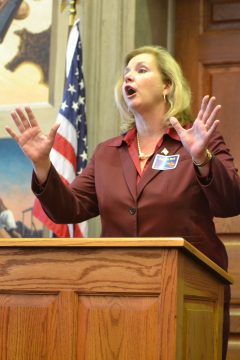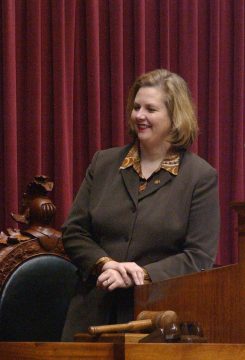Catherine Hanaway, the first female Speaker of the House in Missouri, spent a sizable portion of her political career as a representative transforming Missouri from a national bellwether into a state that has progressively become more crimson in the last decade-and-a-half. After more than ten years outside of elected office, she now hopes to become the state’s next governor.
The protesters chant in the swelter of another Missouri July outside the Planned Parenthood affiliate of Columbia. Recently released videos accusing the reproductive health care organization of trafficking fetal tissue – baby parts, in plainer language said and shouted by the anti-abortion crowd gathered outside the facility – have sparked the latest wave of outrage from pro-life conservatives. Despite an excessive heat warning, over 50 people turn out to hold signs urging the community, politicians, anyone who will listen, to force Planned Parenthood shut its doors for what they call barbaric practices.
 Among them stands Catherine Hanaway. Inches taller than every woman there and rivaling the height of most of the men, she gives the impression of an obelisk, staunch, stoic, unmovable. Hanaway prays with the rest of the protesters, listens to the other featured speakers, nods thoughtfully when they make an emphatic or rousing statement that elicits cheers or jeers directed at the clinic.
Among them stands Catherine Hanaway. Inches taller than every woman there and rivaling the height of most of the men, she gives the impression of an obelisk, staunch, stoic, unmovable. Hanaway prays with the rest of the protesters, listens to the other featured speakers, nods thoughtfully when they make an emphatic or rousing statement that elicits cheers or jeers directed at the clinic.
Then, Hanaway steps into the middle of the fracas. Reporters shove recorders in her general direction (she is running for governor, after all), and the gathered wait for her to speak. Though a politician by trade, her speech sounds more genuine than many of the practiced and repeated orations of some of her peers, and she does not launch into tantrum or outrage for emphasis. Her calm, but impassioned, conviction alone would give her voice gravity in any room, and she owns the crowd as she continues.
She speaks about her time as a federal prosecutor, locking up hardened criminals. Hanaway says despite those gruesome cases, the events described on these video tapes are simply unfathomable.
“In none of those experiences did I ever see the callous disregard for human life that shows up on these videos,” Hanaway said during her speech. “I want you to imagine just for a moment if the procedures described were being performed on puppies, America would be up in arms. It’s time they were up in arms on behalf of the unborn.”
The line is one she will go back to every so often in the coming months as she tours the state by whatever method, be it RV, car, van, bus, or even on foot, going door-to-door with a soldier’s certitude. She is, after all, a veteran of leading, creating, or otherwise getting involved in grassroots, populist efforts just like this rally. Whatever the circumstance or situation, by all accounts, Hanaway fought on the front lines in the war for Missouri’s political soul.
And judging by today’s electoral maps, it appears to be a war she won.
+++
Months after the protest, the gubernatorial election is well underway in early November. A field of five Republican candidates are all fighting for a chance to fight Democratic nominee Chris Koster, who does not have an apparent primary opponent of his own.
Other names have emerged on the GOP’s ticket aside from Hanaway: Lt. Governor Peter Kinder, who led the Senate as she led the House; former Navy SEAL Eric Greitens, an outsider with a huge amount of financial backing; businessman John Brunner, who looks eager to get back into politics after his failed bid for the Republican nomination for Senate in 2012; and state Sen. Bob Dixon, who promises to carry his record of fiscal conservatism from the legislature into the Governor’s Mansion. All have made their intentions for the office known, though Dixon will drop out in December.
However, Hanaway’s name has been on the ticket the longest, and as a result, she has accrued an early and substantial war chest. Popular candidates like Greitens and Kinder have gained ground though, while the independently wealthy Brunner shows no concern for putting his own money forward for a gubernatorial bid.
The five candidates have just met for the first time at a forum put on by the Missouri Farm Bureau in Jefferson City, which is treated as the inaugural debate of the Republican field. Hanaway has also started a month-long RV tour across the state with speaking engagements planned from Hannibal to Joplin and everywhere in between.
Unfortunately for the campaign, the RV has a Missouri Tiger logo on the side of it, donated by a Mizzou tailgater and Hanaway fan. To avoid a possible legal kerfuffle that her staffers say just isn’t worth it, they have covered the logo with black electrical tape, an inelegant, but pacifying and Spartan solution.
As Hanaway and a few of her closest staffers ride back to Columbia for the night in the adhesive-modified camper, they discuss the debate, talk about the coming day’s events, share inside jokes and stories. After starting early in the morning in West St. Louis County, Hanaway had three large campaign events in the past 12 hours but if it had put any strain on her, she certainly does not show it.

It’s probably because Hanaway is used to working late, especially as one of the leaders of the House Republican Campaign Committee in the late 90s and early 2000s. It coincided with the ascendency of George W. Bush to the presidency and a burgeoning unpopularity with Bill Clinton, and subsequently Democrats, over his sex scandal. In Missouri, longtime Democratic leaders in the legislature, who had dominated the statehouse for half a century, were being phased out after term limits came into place in 1992.
It also helped that House Republicans immediately flocked to her side to support the up-and-comer, someone seen clearly as a riser in the rank and file of the party. She became the House Minority Leader at the end of just her first term in office, and successfully united and mobilized a party which had largely been marginalized in the Missouri political scene.
Even with those advantages, Hanaway says the process of building the Republicans up was arduous, but along with her chief of staff at the time, Chuck Caisley, she put in the work.
“[HRCC] had never raised more than $750,000 [in a year],” she says. “I doubled the amount of money we raised, and I did almost all of the fundraising. We didn’t pay a single staffer out of the HRCC, not one… I was in the office most nights til two or three in the morning writing the mail, not shipping it out to some vendor.”
Caisley recalls that even he had to be won over to Hanaway’s way of thinking.
“The first few times she approached me, I turned her down,” he said. “She sat down and had a presentation that had about seven slides in it. She went through every single district she thought Republicans could play in. Most of these were conservative districts, but they had gotten more liberal representation over the years. If we put good solid conservative representatives up in these districts we can take the majority.
“When you sit down and listen to Catherine and you see she has a plan, it’s hard not to get caught up in the excitement.”
Former state Rep. Carl Bearden said Hanaway and Caisley were relentless in making the Republicans the majority party in the state.
“The two of those were almost 24/7 on track,” he said. “They would spend countless hours travelling the state, working on literature for candidates… She poured heart and soul into taking the majority that year.”
Hanaway and Caisley did not merely work hard either. They had a plan.
“She crafted a very, very specific strategy,” Caisley said. “She didn’t waste a lot of time doing things other leaders of the caucus had done. We were very, very, very careful about only investing in races and things we knew were going to have a dividend.”
“She and I would, as early as four or five months out from the election, do a ton of polling. We had found a way to do polling much cheaper, so we were tracking up to 30 or 40 races four or five months out, looking at other metrics, doors knocked by candidates, we would literally sit down and score the races.”
From there, they would use the information to determine which candidates to whom they gave their precious resources.
The hard work and discerning eyes paid off. In 2002, Republicans overtook the Democrats in House seats for the first Republican majority in 48 years, and Hanaway ascended to the Speaker’s chair. That milestone, as well as the Republicans winning a majority in the Senate a year earlier, marked a significant turning point in the state’s political history. Both Houses of the General Assembly now have Republican supermajorities, and more than a decade later, Democrats still seem shell shocked as they have failed to take any significant ground in the war over the aisle.
Hanaway’s effort in 2002 had provided the final push the Republicans needed to win over the electorate.
“I had a ‘Hanaway for Speaker’ committee, and it had I think one employee.” Hanaway said. “He guided many of the efforts on behalf of the races we were targeting, and we targetted 42 races. That same year, the US Congress had 42 targeted races…. It was very different, but I think because it was different is why we were able to get some things accomplished later because we had been in the trenches with those members later and really earned their trust.”
+++

And so Hanaway became the first female Speaker of the House, and while she told MissouriNet in an interview in February that her role as the first mother to hold that position brought a welcome and necessary perspective to government, her first focus was on how to effectively run a legislative body.
“The biggest challenge I faced was going from being the minority leader to leading the Republican Party to win the majority in the Missouri statehouse in 48 years,” she told MissouriNet. “There was not a single speaker of the house I could turn to for counsel.”
After all, she and her Republican colleagues had an agenda. See, Hanaway was not content as merely a vocal member of the minority when Republicans held that title. Her fervency and work ethic sprung not from a desire for personal advancement but to pass conservative legislation based on her principles and the principles of her party.
“It came from a sense of wanting to get results,” she says. “Being in the minority, I could file lots of good legislation, and it would go absolutely nowhere. I was tired of banging my head against a wall.”
So as she transitioned from Minority Leader to Speaker, she immediately set forth to pass such legislation using the new Republican majority. She worked hand-in-hand with the Missouri Right to Life organization to limit abortion access in Missouri and reformed the state’s foster care system after the death of toddler Dominic James, a participant of the program.
She also worked to expand 2nd Amendment rights. Former state Rep. Larry Crawford worked with Hanaway during that period; he sponsored the state’s concealed-carry legislation that gained immediate popularity in the House. However, Hanaway’s district at the time had voted strongly against it when it was on the ballot.
“I was always for it,” she says. “I felt compelled to represent the views of my district. And I ran again, told them I would be for concealed-carry. They still re-elected me, and as Speaker, it was one of our highest priorities to get it done and we did.”
Crawford says her leadership carried that legislation forward.
“We had to have people from both sides of the aisle, and if it wasn’t for her we wouldn’t have concealed carry that’s for sure,” Crawford said. “That’s the leadership. There’s a lot of good people that have been in the legislature, but only a handful that were really leaders and I’d put Catherine at the top of that list.”
And by all accounts, her tenacity had not wavered in the slightest.
“She’s a strong leader and she works late, you could find her in her office or in the house lounge late at night,” Crawford continued. “You knew where you could find her. She was kind of feared by her opponents, not because she should be feared, but because she was so effective.”
However, the Rep. Esther Haywood, a Democrat from St. Louis, said if she had the opportunity she would vote for Hanaway in the next election because despite Hanaway’s strict conservatism she also displayed bipartisanship. Although Republicans had a majority, it was still a small lead, and she had plenty of Democrats she had to appease at times to pass legislation. Haywood was one of those legislators.
“One piece of legislation I got passed, and it never would have got it passed without her,” Haywood said. That bill was more an honorary piece, one that established Feb. 4 as Rosa Parks Observance Day than monumental legislation that would change the foundation of the state, but Haywood said Hanaway did her part to get it through session.
“She knew I had worked so hard for it, and she was willing to get my piece of legislation back to the floor,” Haywood said. “I remember she was an excellent legislator, truly worked across the aisle… If it’s something she has strong convictions about, she’ll get it done. If it’s something good for the people.”
However, not all Democrats found themselves in good graces with her, not the least of which was then-Governor Bob Holden. She and many other Republicans had battled in 2003 over an impasse reached by the two sides on the state’s budget. The vitriol and agitation between the two sides was a fixture of the evening news when a special session was called in Sept. of that year. It was when Hanaway famously made her proclamation, speaking on behalf now of the majority of Missourians, asking Holden “What part of ‘No’ don’t you understand?” about the Republican refusal to raise taxes. Bearden remembers it vividly.
“The whole budget battle during the year was Holden wanted to raise over $700 million in taxes to support his taxes,” Bearden, the House Budget Chair at the time, said. “Holden even called a special session of the legislature in 2003 in an effort to increase revenue for elementary and secondary education, which Republicans decried at the time as fiscally irresponsible; they did not believe the state had the money to pay for more programs while they also looked to lower taxes.
“The special session was all about trying to get us to spend more money than we had,” Bearden continued. “There was a lot of tension.”
Despite the struggles, Bearden said Hanaway showed tremendous leadership for the party.
“She was very strong,” he said. “We were in a meeting one time with the governor, she asked ‘What are your priorities?’ He pushed the [budget] book over to Catherine and said, ‘These are my priorities.’ He refused to work with us or come up with any sort of accommodation because he was not willing to not raise taxes”
Hanaway’s work, as well as the newfound strength of the Missouri Republican party, made those tax increase proposals fail for the most part. The highly-publicized fighting and perceived weakness of Holden throughout the ordeal also led to a shift within his own party. Current U.S. Sen. Claire McCaskill, the state auditor at the time, easily defeated Holden in the Democratic primary, the first time an incumbent governor had lost in a primary election in state history. McCaskill would later lose to Republican Matt Blunt in the general election, which turned the writing on the wall to an etching in stone.
Missouri was a conservative state.
+++
And yet, as the right-wing continued its rise into borderline omnipotence, Hanaway faltered for the first time in her political career. She decided to run for Secretary of State in 2004 and lost to Robin Carnahan, the newest in a generation of one of Missouri’s most influential political families. She would go on to serve in that role until Jason Kander took over in 2013.
After that, Hanaway stayed in government, but returned to her roots as a prosecutor. After helping George W. Bush win the state in 2000 as his campaign manager in Missouri, President Bush appointed her as the U.S. Attorney for the Eastern District of Missouri.
Assistant U.S. Attorney Jeff Jensen served with Hanaway, and prior to that he had a deep familiarity with the process as an FBI agent. He said Hanaway was one of the best.
“She was fantastic,” Jensen said. “One of the most well respected US attorneys there has been in the Eastern District in Missouri in my time. I would say that her points of emphasis were reducing violent crime and fighting crimes against children. I would describe her as one of the very few people I know that is absolutely brilliant, but also has common sense.
“What made her so well respected was her candor… she’s extremely direct. You do not wonder about her stance on issues. I’ve also seen her ethics in the dark – tough decisions that had to be made when nobody was watching. And she always made the most ethical decision.”
A brief investigation into some of the cases Hanaway handled show she took her job seriously. She protected whistleblowers who alleged that a company was defrauding Medicare, sent multiple child pornographers to prison, fought against manufacturers of methamphetamine. Jensen noted it was not just the quantity of the cases she prosecuted, it was they way in which she did it.
“What was unusual is that often times U.S. attorneys do not actually go into court and try cases themselves, especially in the modern era,” Jensen said. “She was one of the few that I’ve seen that walked into court and tried cases.”
Again, another chapter of her story where someone says she did the work herself. And that industriousness carries within it the true motivation behind Catherine Hanaway and why exactly she wants to make a comeback into the political scene.

After all, she has a growing family with her husband, Chris. Her daughter, Lucy, and son, Jack, are 16 and 12 now respectfully, and according to an interview with the St. Louis Beacon in 2009, wanting to see her children grow provided much of the impetus for her retirement from the U.S. Attorney’s office.
But back on the RV, as we slog through the dark night after a long day, she tells me that feels compelled to re-enter into politics specifically for her children and for the children of all other families in the state. Her service is not directed by God, but rather motivated and pushed by her Catholic faith. That belief kept the midnight oil lit on all those long nights. It shaped her ability to work and lead and coalition and and legislate gain the respect of her conservative colleagues, and demand it from her liberal opponents.
She is not a Michelle Bachman or Ted Cruz or Bobby Jindal who all proclaimed God directly told them to run for the highest office in the land. Instead, she simply saw what gifts she had and used them to help people. She laughs that she never thought she had the right skills to be a teacher or a nurse, but she found a niche in leadership and governance ever since she became president of her Future Farmers of America club in high school in rural Nebraska.
“To whom much is given, from whom much will be expected,” she says simply. “I think that God has given me all the important great things in life. One is to know Him, two is great parents and great kids and a great husband. If you get those things in life, I think you’re called upon to make as much of it as you can.”
For Hanaway, her faith goes hand in hand with her conservatism. To her, each life is an act of grand, incomprehensible and beauteous Creation, and fostering the rights of persons supersedes all else. She values the supremacy of the individual over the institution.
“I think the individual can take great responsibility for themselves,” she says. “I think the individual’s rights under the constitution should be preserved, but if we don’t start with the dignity of that individual life, then you don’t have that same fundamental belief that individuals can solve problems as opposed to, we have to trust the government to solve all of the problems. For me, being a conservative all goes back to that belief in the greatness of this being created by God that any man or woman can do anything that we’re given the chance to do and get all of the old institutions that stand in their way out of the way.”
With her eyes on the governor’s chair, Caisley believes she could win the nomination.
“Nobody believed she was going to take a majority in the Missouri house,” he says. “A decade later, she’s going to have to do the exact same thing she did before. She’s going to take everyone by surprise. I think the day after the election a lot of people are going to be scratching their heads wondering, ‘How the heck did that happen?'”







